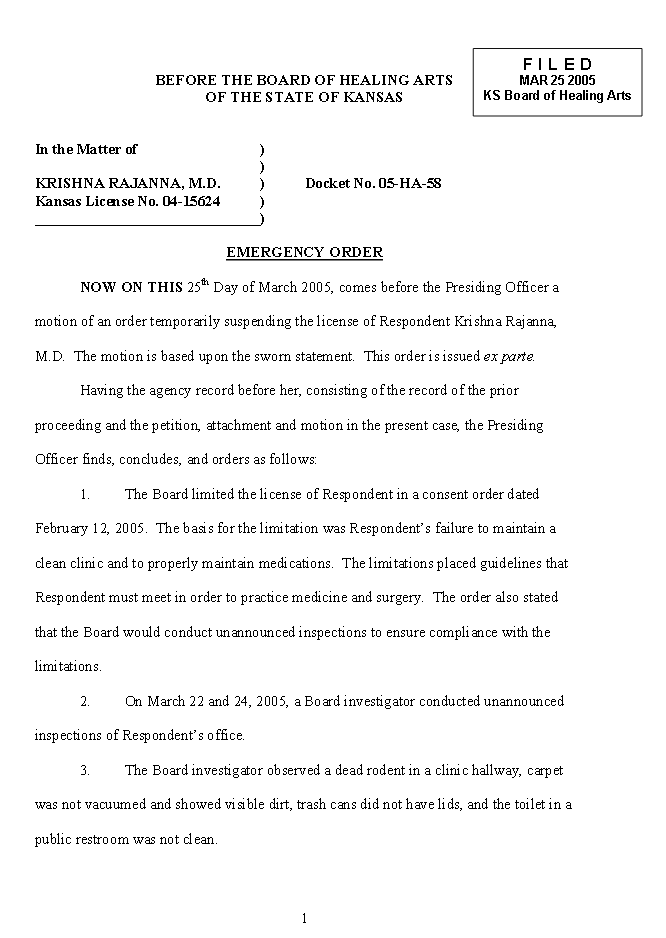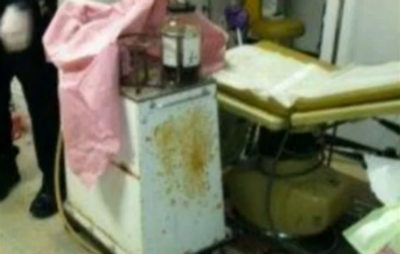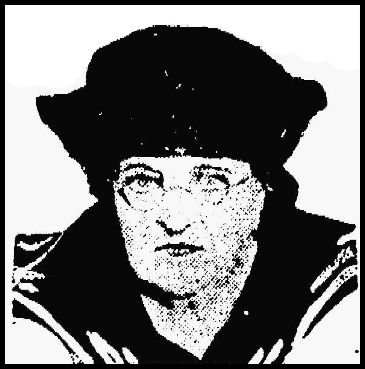What do
Kermit Gosnell,
Krishna Rajanna, and
Robert Alexander all have in common? Aside from being quacktastic abortionists, I mean.
The answer? They're quacktastic abortionists whose quackery was only discovered when cops went to their clinics for totally unrelated issues.
Kansas City, 2003: Dr. Krishna Rajanna
 |
Combination patient
bathroom and
"sterilization room" |
On September 18, 2003,
two Kansas City detectives went to Krishna Rajanna's Afordable Medicine Clinic in response to his report that his employees had been stealing from him.
Inside the cops found clutter and filth. They didn't even want to sit down to take statements because of how nasty the place was.
Cockroaches were scuttling among trash and dirty dishes in the rank, grungy break room. Styrofoam cups containing aborted fetuses were stored in the freezer with the employees' food. More than one employee told police that Rajanna had microwaved what was in one of the cups and stirred it into his lunch.
There wasn't a washable floor in the procedure room. There was carpet -- blood-stained carpet. Rajanna himself was as unkempt as his facility, with dirty hands and uncombed hair.
 |
Medical board document.
Click to enlarge. |
Employees told the police that medical instruments were cleaned with Clorox then run through a dishwasher. The dishwasher in question was just a few feet from the toilet for patient use. The combination "sterilization room" and patient restroom was as filthy and cluttered as the rest of the clinic.
One police officer testified to the legislature, "I am an experienced police officer who has worked in every aspect in law enforcement and had spent my last five years in the homicide unit where I worked countless community deaths. I thought I had heard and seen every vile, disgusting crime scene but was in for a new shock when I started this investigation."
In February of 2005, a year and a half after the police stepped into his clinic, the state finally got around to doing something about Rajanna.
He was fined $1,000 and had his medical license suspended for a week. An emergency suspension was finally imposed later in 2005 after
a surprise inspection revealed a dead rodent in the hallway in addition to the general squalor of the place.
Philadelphia, 2010: Dr. Kermit Gosnell
On February 18, 2010, the FBI and Philadelphia detectives
raided Kermit Gosnell's clinic, Women's Medical Society, expecting to find a pill mill. They were shocked to discover flea-infested cats roaming freely through a filthy abortion clinic where women lay stuporous and moaning on blood-stained recliners. A stench of urine filled the air. There was blood on the floor. Cat feces and cat hair were found everywhere, even in the procedure rooms which one police officer likened to "a bad gas station rest room."
 |
| Procedure room table in Gosnell's clinic |
To describe the medical equipment as unsanitary would be a gross understatement. The procedure room table was caked with dried blood. The oxygen mask and tubing were coated with a thick layer of gray grunge. The corroded tubing for the suction machine was the only tubing available should a patient need to have her airway suctioned. Except for a single blood pressure cuff, none of the monitoring equipment was functional.
The remains of aborted fetuses were stockpiled all over the place: in bags, in orange juice cartons, in empty cat food containers. Sometimes containers of fetal remains would leak onto the dirt floor of the basement. A row of jars contained severed fetal feet.
 |
| Anesthesia chart for the clinic |
A thorough investigation found that unlicensed staff -- often not even high school graduates -- were routinely doping patients up to keep them quiet until Gosnell would arrive later in the day to do their abortions. The chart they consulted for dosages was drawn up by a
15-year-old employee that had been given some marginal on the job training.
If the babies were born alive -- which they were on a daily basis --
Gosnell or one of his employees would sever the baby's spine at the base of the skull with surgical scissors.
In spite of these conditions, Gosnell had a steady stream of patients referred to him by other abortion clinics in neighboring states in addition to patients he picked up while
moonlighting at a National Abortion Federation member clinic in Delaware one day a week.
Gosnell was arrested. He was eventually found guilty of the murders of three of the infants that had been born alive and is currently serving a life sentence. And, having entered the building with law enforcement, state officials were more or less forced to shut the clinic down immediately.
Muskegon, 2012: Dr. Robert Alexander
 |
| Procedure room at Dr. Robert Alexander's clinic |
On December 26, 2012, Muskegon,
Michigan police responded to a report of a break-in at Robert Alexander's Women's Medical Services. They found blood on the floors and walls, uncovered buckets of unidentified fluids in the surgical area, blood dripping from the sink trap in a patient room, biohazard bags on the floor and in closets, and unsterilized medical equipment.
Medications and used hypodermic needles were strewn throughout the facility, along with confidential patient records.
The place was also such a fire trap -- combustible materials near ignition sources, no fire extinguishers, and so on-- that the fire department shut it down by emergency order the next day.
An investigation was triggered by this report. Two of Alexander's employees told the medical board that the conditions the police found were typical during day-to-day operation of the facility. The facility remains closed, but Alexander remains licensed.
More Questions Than Answers
Every time a rock gets turned over and a Gosnell or an Alexander or a Rajanna scurries for cover,
when a visit to an abortion clinic looks like an episode of
Hoarders, how does the abortion lobby respond?
Do they call for emergency inspections of other abortion facilities in the state to make sure there are no other dangerous quacks running dens of squalor? Do they demand to know why this was permitted to continue? Do they declare that abortion safety is an area of common ground where prolife and prochoice can work together to shut down the Gosnells and Alexanders and Rajannas?
The typical response is to lie low and wait for it all to blow over. When the Gosnell case finally got national attention,
abortion-rights advocates and their media lapdogs had the audacity to blame prolifers -- who try to shut such clinics down -- with the very existence of such a place.
The choice made by Gosnell to run such a cesspool, the
choice made by a prochoice governor to order a halt to abortion clinic inspections, the repeated choices by state officials to turn a blind eye to
alarming reports about the goings-on at 3801 Lancaster, the choice by a
National Abortion Federation member clinic to hire Gosnell and hand off patients to him, the
repeated choices by reputable abortion facilities to refer women -- including the hapless
Karnamaya Mongar -- to Gosnell, and the choice by the National Abortion Federation to keep quiet about what was happening rather than try to shut him down -- none of these were identified as so much as contributing factors.
Abortion-rights groups and their media lapdogs continue to insist that, in spite of the Gosnells and the Alexanders and the Rajannas, all is well in Choiceland, that state oversight and inspections are a needless and vindictive burden to abortion providers. Active attempts to identify and shut down clinics, even marginal clinics, will "limit access" to "safe, legal abortions."
I suspect that, like the governor of Pennsylvania, they fear that turning over rocks will only reveal more creepy-crawlies, which will raise questions about exactly what it is the abortion lobby is defending with their dogged campaigns to keep everybody -- including themselves -- in the dark about what is really going on behind the closed doors of abortion clinics.
They don't seem to be defending women's access to
safe abortion services.























